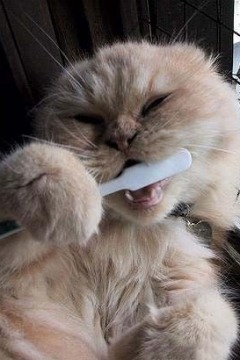Here are five steps to help your animal companion’s teeth and gums remain healthy:
1. Beware of Bad Breath
If a musky scent is coming from Fluffy’s mouth, do not ignore it. This could be a warning sign that she has periodontal disease or another oral disease such as stomatitis, a common feline condition that causes painful inflammation of the gums and mouth tissues.
Other dental-health warning signs include bleeding gums, yellow or brown teeth, pawing at the mouth, and loose or missing teeth.
2. Brush Your Companion’s Teeth
While it might be difficult at first, with enough patience and plenty of yummy rewards, you can turn tooth brushing into a bonding experience with your dog or cat. It might take several weeks to train your four-legged friend to warm up to the toothbrush, so start by letting her smell the toothbrush and pet toothpaste, then gradually work your way to brushing for 30 seconds on each side of her mouth at least every other day. By the way, human toothpaste is not safe for pets, so be sure to use a product approved for your animal companion.
If you are scared your dog or cat will bite you, ask your veterinarian for alternative tartar-control options.
3. Consider Dental Toys, Treats and Food
While it is not as effective as brushing your companion’s teeth, giving her treats, toys and food specifically designed to promote oral health will help her maintain healthy gums and teeth. Be sure to choose products that meet the standards for effective plaque and tartar control.
4. Ask Your Vet for a Dental Exam
Humans are not the only ones who need their chompers checked by a professional; your four-legged friend needs to have her teeth and gums checked by a veterinarian. During the dental exam, the vet will first take your pet’s medical history, then ask if you have noticed any dental health warning signs such as bad breath.
Next, he will examine your companion, including checking the head and neck for any abnormalities. Finally, he will check out your companion’s teeth and gums for redness, bleeding and inflammation. He will also be on the lookout for tooth loss, cracked teeth, plaque and tartar, as well as potentially cancerous lumps and bumps.
A cursory dental exam can usually be performed without sedation, unless your companion becomes aggressive or his teeth are very painful. For a complete dental evaluation, though, your companion will have to go under.
5. Don’t Let Anesthesia Stop You From Getting a Dental Cleaning
To thoroughly examine your companion’s teeth and gums, properly get rid of nasty plaque and tartar, and really clean your companion’s pearly whites, he will need to be anaesthetized. Though sedating your dog or cat sounds scary, it is not as bad as it sounds – in fact, the procedure has never been safer or more comfortable. Before your vet even begins anesthesia, he may recommend prescreening tests to help ensure that your companion is healthy enough for the procedure.
When you think about it, the benefits of dental cleaning outweigh the possible risks of anesthesia. When Fluffy wakes up, her breath will smell better, and her teeth will be shinier and healthier. And as an extra bonus, maintaining healthy teeth and gums helps protect the body’s other organs, like the heart and kidneys, from the damaging effects of dental disease.




